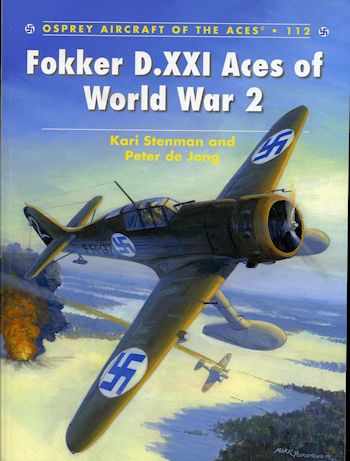 The Fokker
D.XXI was developed to be a simple, rugged and easy to maintain fighter for the
Netherlands East Indies. As such, it had a fabric covered tube frame
construction with fixed landing gear. Despite some early resistance to it caused
by the crash of the prototype in the hands of an inexperienced test pilot, it
went on to be built in fair numbers.
The Fokker
D.XXI was developed to be a simple, rugged and easy to maintain fighter for the
Netherlands East Indies. As such, it had a fabric covered tube frame
construction with fixed landing gear. Despite some early resistance to it caused
by the crash of the prototype in the hands of an inexperienced test pilot, it
went on to be built in fair numbers.
The initial crash caused its initial cancellation for
Dutch service, though that was shortly rescinded. The aircraft was found to be
just the ticket for the Finns who ordered several and got a license to build
them. Same for the Spanish, though as the fortunes of war would have it, only
one aircraft was actually built and never photographed. Denmark also ordered the
aircraft. All of these were Mercury powered.
The Dutch aircraft were quickly built and were in
squadron service by the time of the German invasion of 1940, but the first to
use them in combat were the Finns during the Winter War of 1939-1940. This was a
rather short conflict of only a few months, but the D.XXI, operating with skis,
showed itself to be a very able performer. Many Finnish pilots were able to rack
up a pretty decent score with the D.XXI. In fact, at the start of the conflict,
the D.XXI was the most modern fighter in Finnish service. Though other planes
came into Finland during that war from Italy, the UK and France, it was the
D.XXI that did most of the fighting.
Next to use it were the Danes, though the country
surrendered before any combat missions could be flown. The Dutch were fairly
successful with the D.XXI, gaining several victories over intruding German recce
planes prior to their entry into the war, and having some success once the
German invasion was underway. Though not up to the capabilities of the Bf-109E,
the Fokker was able to knock down several transports as well as some bombers,
110s and a 109 or two. According to the book, no Dutch pilot ever achieved ace
status, even those fighting with the British.
During the Continuation War, the D.XXI had be supplanted
for the most part by more modern aircraft like the Buffalo, P-36, Hurricane and
later the Bf-109. Still, the D.XXI was able to continue knocking down planes.
Thanks to a lack of Mercury engines, the Twin Wasp Jr was used for the last 50
or so built. This had a slight degradation in total performance, but not enough
to be all that noticeable. A full dozen Finnish pilots became aces flying the
D.XXI while a couple of dozen more got some of their victories in the aircraft.
This book covers the development of the D.XXI as well as
its use by all the nations that flew it. Naturally, most of the book covers the
Finnish AF use followed by a good sized section on the Dutch A.F. during its
homeland defense use. This is further enhanced by a great selection of period
photos and the usual collection of full color profiles. Several charts make up
the appendices to add additional flavor to the book.
It all makes for a very interesting read, especially if
you are looking for something a bit different from the norm. It is well written
and tells the tales well. It was a book I very much enjoyed reading and can
highly recommend it to you.
May 2013
For more on the complete line of Osprey books,
visit www.ospreypublishing.com. In the US, it is
Osprey Direct at 44-02 23rd St, Suite 219, Long Island City, NY 11101., where you can
get a catalogue of available books.
If you would like your product reviewed fairly and quickly, please
contact
me or see other details in the
Note to
Contributors.
 The Fokker
D.XXI was developed to be a simple, rugged and easy to maintain fighter for the
Netherlands East Indies. As such, it had a fabric covered tube frame
construction with fixed landing gear. Despite some early resistance to it caused
by the crash of the prototype in the hands of an inexperienced test pilot, it
went on to be built in fair numbers.
The Fokker
D.XXI was developed to be a simple, rugged and easy to maintain fighter for the
Netherlands East Indies. As such, it had a fabric covered tube frame
construction with fixed landing gear. Despite some early resistance to it caused
by the crash of the prototype in the hands of an inexperienced test pilot, it
went on to be built in fair numbers.